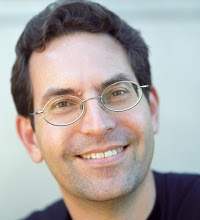 In a great post, "Doctor as Designer" Joyce Lee laments the "sad state of product and design in healthcare," and asks "when will device and drug companies create user-centered innovations that actually improve the lives of patients instead of their bottom line?" I heartily agree with Dr. Lee's point, and think the question can be extended to the rest of the health care system. Dr. Lee uses two examples to compare health care to consumer goods. Heinz took a product design -- the glass ketchup bottle -- that had been around for over a hundred years, and greatly improved the user experience by changing to a squeezable "upside down" bottle. This not only kept the ketchup from concentrating at the bottom but also avoided the need to hold the bottle at a special angle or to tap at a particular spot just to get the ketchup out...
In a great post, "Doctor as Designer" Joyce Lee laments the "sad state of product and design in healthcare," and asks "when will device and drug companies create user-centered innovations that actually improve the lives of patients instead of their bottom line?" I heartily agree with Dr. Lee's point, and think the question can be extended to the rest of the health care system. Dr. Lee uses two examples to compare health care to consumer goods. Heinz took a product design -- the glass ketchup bottle -- that had been around for over a hundred years, and greatly improved the user experience by changing to a squeezable "upside down" bottle. This not only kept the ketchup from concentrating at the bottom but also avoided the need to hold the bottle at a special angle or to tap at a particular spot just to get the ketchup out...
News
Clinical Trial Design Management: Best Practices for Small Budget Studies
 ClinCapture hosted the 12th BioTalks in Park City, UT, on the topic of Clinical Trial Design & Management: Best Practices for Small Budget Studies. This was the first event in the series hosted in the biotech hub of Salt Lake City. The panel discussion gathered experts from CROs and sponsor companies to conduct quality clinical trials in a cost effective manner. Industry experts shared their knowledge on running high quality, small budget clinical trials covering clinical operations to clinical data management and biostatistics...
ClinCapture hosted the 12th BioTalks in Park City, UT, on the topic of Clinical Trial Design & Management: Best Practices for Small Budget Studies. This was the first event in the series hosted in the biotech hub of Salt Lake City. The panel discussion gathered experts from CROs and sponsor companies to conduct quality clinical trials in a cost effective manner. Industry experts shared their knowledge on running high quality, small budget clinical trials covering clinical operations to clinical data management and biostatistics...
- Login to post comments
- News
Pardon Me, Your Interface Is Showing
- Login to post comments
- News
Building an Open Medical Records System for the Developing World
 How do you introduce a woman whose very life is the epitome of humanitarian efficacy? Judy Gichoya is a Kenyan medical doctor specializing in radiology and an experienced programmer who's accelerating the growth of OpenMRS. According to its website, "OpenMRS is a software platform and a reference application which enables design of a customized medical records system with no programming knowledge." Judy first got interested in computers in high school, prior to entering medical school she learned to program at a technical college and through online resources on the internet...
How do you introduce a woman whose very life is the epitome of humanitarian efficacy? Judy Gichoya is a Kenyan medical doctor specializing in radiology and an experienced programmer who's accelerating the growth of OpenMRS. According to its website, "OpenMRS is a software platform and a reference application which enables design of a customized medical records system with no programming knowledge." Judy first got interested in computers in high school, prior to entering medical school she learned to program at a technical college and through online resources on the internet...
- Login to post comments
- News
CMS To Invest $5+ Billion a Year in Open Source and Cloud-based IT Infrastructure for Medicaid
 After more than 40 years of relying on monolithic mainframe platforms to administer its services, the Centers for Medicare & Medicaid Services (CMS) has embraced a new modular, open and agile approach to Medicaid health information technology for the Federal government and States. In many ways, this is the best of what open source advocates and technology innovators could have hoped for when it comes to open source policy from a government agency. According to Andrew Slavitt, Acting Administrator of CMS, the agency will spend more than $5 billion a year to fund this transformation.
After more than 40 years of relying on monolithic mainframe platforms to administer its services, the Centers for Medicare & Medicaid Services (CMS) has embraced a new modular, open and agile approach to Medicaid health information technology for the Federal government and States. In many ways, this is the best of what open source advocates and technology innovators could have hoped for when it comes to open source policy from a government agency. According to Andrew Slavitt, Acting Administrator of CMS, the agency will spend more than $5 billion a year to fund this transformation.
- 1 comment
- News
How to Design Your Open Source Project to Encourage Participation
 Working openly means designing for participation. "Designing for participation" is a way of providing people with insight into your project, which you've built from the start to incorporate and act on that insight. Documenting how you intend to make decisions, which communication channels you’ll use, and how people can get in touch with you are the first steps in designing for participation. Other steps include working openly, being transparent, and using technologies that support collaboration and additional ways of inviting participation. In the end, it’s all about providing context: Interested people must be able to get up to speed and start participating in your project, team, or organization as quickly and easily as possible...
Working openly means designing for participation. "Designing for participation" is a way of providing people with insight into your project, which you've built from the start to incorporate and act on that insight. Documenting how you intend to make decisions, which communication channels you’ll use, and how people can get in touch with you are the first steps in designing for participation. Other steps include working openly, being transparent, and using technologies that support collaboration and additional ways of inviting participation. In the end, it’s all about providing context: Interested people must be able to get up to speed and start participating in your project, team, or organization as quickly and easily as possible...
- Login to post comments
- News
Out With the Old...Wait, Not in Health Care
 The last company still manufacturing VCRs announced it has ceased their production. VCRs had a good run, most households had one, but their time has passed. Meanwhile, the stethoscope is celebrating its 200th birthday, and is still virtually the universal symbol for health care professionals. There has got to be a moral in there somewhere. VCRs revolutionized our TV viewing experience. We could record television shows to not only watch programs at our own convenience, but we could also fast forward through commercials! We could watch the movies we wanted, when we wanted to, in the comfort of our own homes. Video rental outlets popped up everywhere, from boutique neighborhood stores to wildly successful chains like Blockbuster...
The last company still manufacturing VCRs announced it has ceased their production. VCRs had a good run, most households had one, but their time has passed. Meanwhile, the stethoscope is celebrating its 200th birthday, and is still virtually the universal symbol for health care professionals. There has got to be a moral in there somewhere. VCRs revolutionized our TV viewing experience. We could record television shows to not only watch programs at our own convenience, but we could also fast forward through commercials! We could watch the movies we wanted, when we wanted to, in the comfort of our own homes. Video rental outlets popped up everywhere, from boutique neighborhood stores to wildly successful chains like Blockbuster...
- Login to post comments
- News
Reducing My Digital Burden
 Last weekend, I started a process that some may consider regressive. I began deleting my social media accounts to improve the signal to noise ratio in my life. 10 years ago I wrote about the importance of social media and building networks of colleagues, collaborators and relationships. During that decade our social norms have changed to the point that we walk off cliffs, text while driving, and document every microsecond of our lives on devices that have become the centerpiece of our waking hours. The problem has gotten so profound that Google has introduced artificial intelligence technology to respond to messaging for you - “LOL”, “cute dog”, “a movie at 7pm is great”...
Last weekend, I started a process that some may consider regressive. I began deleting my social media accounts to improve the signal to noise ratio in my life. 10 years ago I wrote about the importance of social media and building networks of colleagues, collaborators and relationships. During that decade our social norms have changed to the point that we walk off cliffs, text while driving, and document every microsecond of our lives on devices that have become the centerpiece of our waking hours. The problem has gotten so profound that Google has introduced artificial intelligence technology to respond to messaging for you - “LOL”, “cute dog”, “a movie at 7pm is great”...
- Login to post comments
- News
U.S. Government Seeks Reduced Use of Custom Software, Releases New Policy to 'Free the Code'
 As I've written before, there has been a shift, going back almost a decade, away from the debate over whether to use open source to a focus on the how to. The release by the Office of Management and Budget (OMB) of the U.S. Federal Source Code Policy on August 8th is the latest manifestation of this shift. It achieves the goal laid out in the Obama administration's Second Open Government National Action Plan (PDF) for improved access to custom software code developed for the federal government. The plan emphasized use of (and contributing back to) open source software to fuel innovation, lower costs, and benefit the public. It also furthers a long-standing "default to open" objective going back to the early days of the administration...
As I've written before, there has been a shift, going back almost a decade, away from the debate over whether to use open source to a focus on the how to. The release by the Office of Management and Budget (OMB) of the U.S. Federal Source Code Policy on August 8th is the latest manifestation of this shift. It achieves the goal laid out in the Obama administration's Second Open Government National Action Plan (PDF) for improved access to custom software code developed for the federal government. The plan emphasized use of (and contributing back to) open source software to fuel innovation, lower costs, and benefit the public. It also furthers a long-standing "default to open" objective going back to the early days of the administration...
- Login to post comments
- News
Trends in Corporate Open Source Engagement
 In 1998, I was part of SGI when we started moving to open source and open standards, after having been a long-time proprietary company. Since then, other companies also have moved rapidly to working with open source, and the use and adoption of open source technologies has skyrocketed over the past few years. Today company involvement in open source technologies is fairly mature and can be seen in the following trends...
In 1998, I was part of SGI when we started moving to open source and open standards, after having been a long-time proprietary company. Since then, other companies also have moved rapidly to working with open source, and the use and adoption of open source technologies has skyrocketed over the past few years. Today company involvement in open source technologies is fairly mature and can be seen in the following trends...
- Login to post comments
- News
Creating Affordable Solutions with Open Source Tools
 Open source is often the heart of many civic technology solutions because using open source leverages the minds of many. Small web solution providers, in particular, often turn to open source as a way to deliver services without having to reinvent the wheel. I recently found out about Digital Deployment, a civic web solution provider in Sacramento, that leverages open source, and so I asked them to share their story with me. I chatted on the phone with Chief Operating Officer Sloane Dell'Orto and Lead Software Engineer Dennis Stevense...
Open source is often the heart of many civic technology solutions because using open source leverages the minds of many. Small web solution providers, in particular, often turn to open source as a way to deliver services without having to reinvent the wheel. I recently found out about Digital Deployment, a civic web solution provider in Sacramento, that leverages open source, and so I asked them to share their story with me. I chatted on the phone with Chief Operating Officer Sloane Dell'Orto and Lead Software Engineer Dennis Stevense...
- Login to post comments
- News